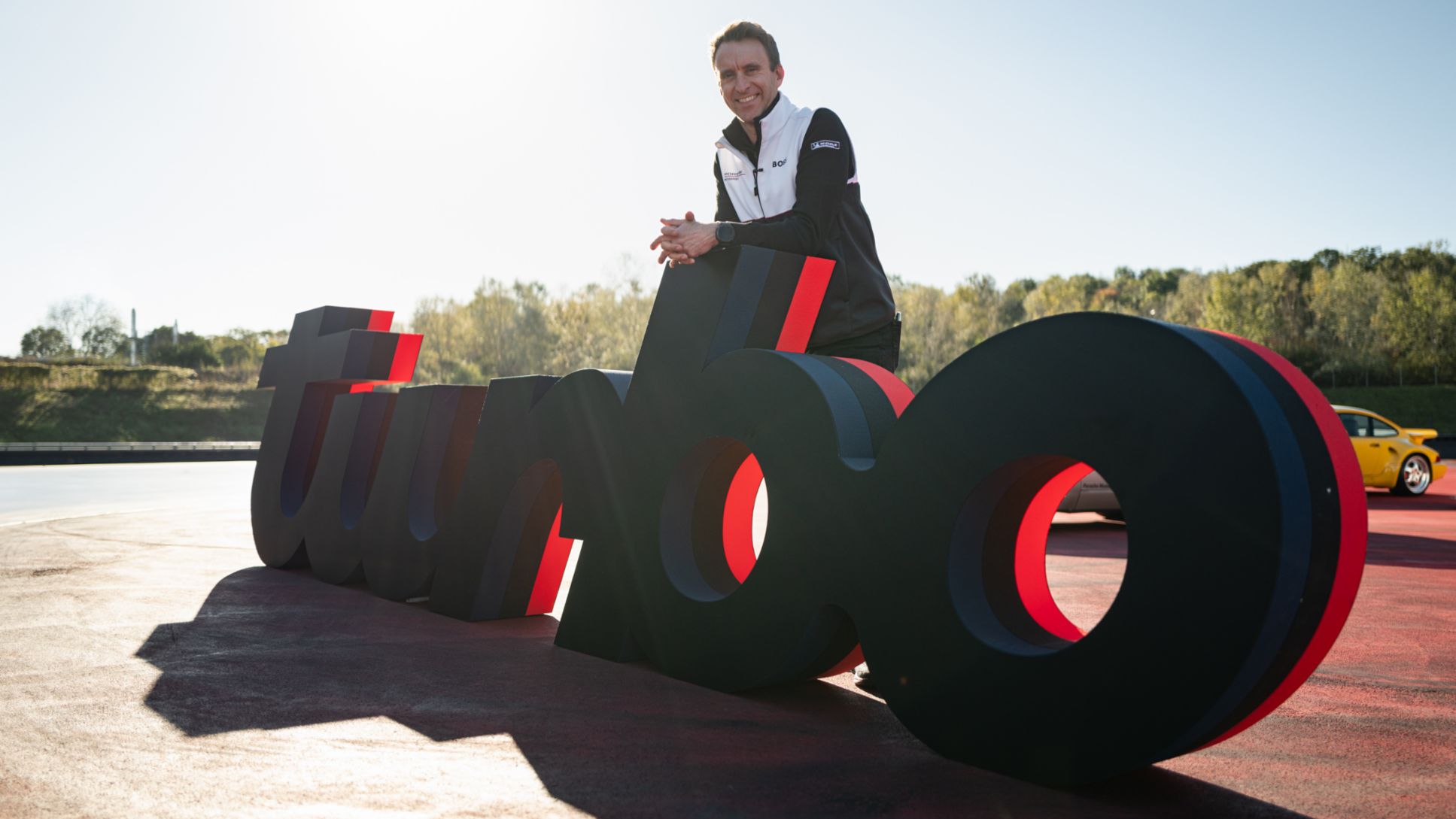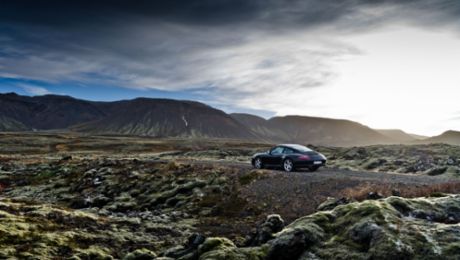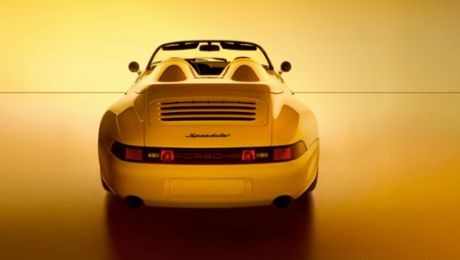Winning streaks, record laps, moments of alarm, and three whiskys – everyone who has experienced Porsche turbo technology has their own very personal story. Here, renowned racing drivers and engineers tell us what ‘Turbo’ means to them.
Walter Röhrl
The two-time World Rally champion, development driver and brand ambassador on his own personal turbo journey.
Superior
I first drove the 911 Turbo 3.0 in 1978. The handling of the car presented a challenge, but I was impressed by its power – so in 1979, I bought a 911 Turbo 3.3. I associate Porsche turbo technology in motorsport with power, success – and good friendship. The year 1981 was intense. Driving a 935 with irrepressible rear-wheel-drive power in the wet at Silverstone was a real balancing act. At Le Mans, we completed the distance very well in a 944 prototype. Friends of mine at Porsche built me a 924 Carrera GTS for the German Rally Championship, in which we celebrated four overall victories. Four years later, we carried on in the 911 Turbo S Le Mans GT. 500 PS in a car weighing 1,000 kilograms and without any downforce to speak of – that was quite the adventure.
Today, the 992-generation 911 Turbo is the best car in the world for me. The Turbo is effortless; incredibly powerful and quiet over long distances. I often get fuel consumption of nine litres per 100 km with this Porsche. High performance and incredible comfort: the original idea for the Turbo is alive and well. More so than ever before if you ask me.
Peter Falk
Head of the testing department during the era of the first 911 Turbo, and later head of motorsport behind the success of the Group C 956/962, the TAG-Turbo ‘made by Porsche’, and the 959 Paris-Dakar.
Those ‘Wow!’ moments
The 911 Turbo was developed in an era that actually ought to have heralded the end of the 911. I think it helped that our incoming Chairman of the Executive Board, Dr Ernst Fuhrmann, had witnessed the success of the newly turbocharged 917 Spyder in America. Making the 911 Turbo drivable for skilled everyday drivers was an enjoyable challenge, although there were initially a few hairy moments for us, as the chassis was somewhat overwhelmed by the power and weight of the car. Our test cars were capable of almost 300 km/h.
The decision-making processes at that time would be inconceivable today. For example, in spring 1977 I was able to convince Dr Fuhrmann to use the brake system derived from the 917 racing car in the roadgoing 911 Turbo 3.3. Fuhrmann was initially not a fan of this idea, saying: “Why brake at all? We want people to drive.” After three whiskys we finally got his approval. Our conversation took place at the launch of the 928, at a bar in the south of France.
Valentin Schäffer
Head of racing engines from 1964 to 1991, he was instrumental in developing the turbo engines for motorsport and is known to this day as the‘Turbo Wizard’. Here Schäffer recalls the winning engine from the Group C 956/962.
From America to Le Mans
The decision to enter Le Mans in 1981 came very late. As a result, we needed an engine that was capable of winning – and fast. I proposed the 2.65-litre flat-six to our Executive Board member for development, Helmuth Bott – the engine I had made for a now-cancelled US project. For Le Mans I had to remodel the engine from a single turbo to a twin-turbo configuration, and from running on methanol to running on petrol. Bott was sceptical: “Will you manage this in time?” I replied: “I have to.” We won Le Mans.
The rules for 1982 cut permitted fuel consumption levels drastically. We reduced the boost pressure from 1.2 to 1.0 bar, leaving ourselves with around 580 PS. It was still enough to take the first three positions in the race. In 1983, to further reduce the fuel consumption we replaced the mechanical Kugelfischer injection with the Bosch Motronic 1.2 and achieved a very drivable 640 PS. In practice for Le Mans 1985, we used the entirely water-cooled 3.0-litre twin-turbo for the first time, which delivered 650 PS in racing trim. With this later descendent of the original US engine, we won in both 1986 and 1987. I was retired by the time the engine took one more victory in 1994.
Timo Bernhard
Porsche works driver from 2002 to 2019, winner of many championships, two-time winner at Le Mans, and World Endurance Champion.
Beginning, highlights and history
I started as a works driver in 2002 and had my first Turbo experience in 2003. I entered the 24-hour race on the Nordschleife in a 996-generation 911 Turbo run by Manthey Racing. The engine had well over 600 PS and driving this car was really wild. We came third, and I’ll never forget what it was like driving this 911 on the Nordschleife. The 919 Hybrid – and its high-tech combination of an electric motor plus a V4 turbo petrol engine – was our winning car at Le Mans in 2017, and we won two World Endurance Championships with it. In 2018, I drove the most extreme lap of my life on the Nordschleife with the Evo version of the 919 Hybrid, which delivered more than 1,000 PS. My time was 5:19.55 minutes, with an average speed of 233.8 km/h, and a top speed 369 km/h. These days, I sometimes take racing cars from the Porsche Museum out for a drive to experience at first hand how the turbo engine developed. In the brutal 917/30 Spyder or the 935/78 ‘Moby Dick’, the turbo feels like a power switch. The Group C 962, meanwhile, is incredibly powerful, but more drivable. The beginning, my highlights, and delving into history – all this is what ‘turbo’ means to me.
Alwin Springer
As a partner in Californian company Andial and a motorsport specialist, one of the main protagonists in many of the Porsche racing successes in America. President of Porsche Motorsport North America from 1990 to the end of 2003.
Thank you, 911 Turbo!
In January 1990, I became head of Porsche Motorsport North America (PMNA). They were interesting times. The economy had stalled and, after legendary success, our 962 was retired from racing. There was no sign of a new Porsche racing prototype that could win, with Weissach focusing on the Indy and a Formula One engine. Bob Carlson, the Porsche press representative in America, and I came up with an idea: 1991 was going to be the year of the IMSA Supercar Championship for near-series sports cars, with a lot of interest from manufacturers. Our 964-generation 911 Turbo could have been tailor-made for this series, and this particular Turbo was not selling well at the time. So we entered the Supercar series. Weissach was on board, sending two 911 cars for PMNA to fine-tune for racing. We won the championship in 1991 with our very popular drivers Hans-Joachim ‘Strietzel’ Stuck and Hurley Haywood. Sales of the 911 Turbo picked up again and PMNA was back on the podium. Customer sport began to thrive and we started on a new, successful course: Gran Turismo Sport. Thank you, 911 Turbo!
Roland Kussmaul
For 40 years until his retirement in 2009, Roland Kussmaul was one of the leading engineers in the development of racing cars and roadgoing sports cars, which he also tested to the limit as a driver.
Practically unbeatable
Down through the years, ‘turbo’ was a hot topic. During a comparative test, I was in the 1,000 PS 917/10 Spyder from 1972 and Jürgen Barth was driving a 936 Spyder from 1976 with just 540 PS, with the two cars weighing about the same. On command, we each floored the accelerator in third gear. The 936 was already 100 metres ahead when the power in my car suddenly made the rear wheels spin. In the early 1980s, the development of the Group C 962 suggested to me that state-of-the-art electronics were vastly improving the power delivery. Soon afterwards came our TAG-Turbo for Formula One. With a steady 720 PS from 1.5 litres of displacement, I found the responsiveness to be almost on a par with that of a naturally aspirated engine. However, the sequential turbocharger of the 959 for the 1986 Paris-Dakar Rally was the crowning glory. A small turbo was activated at lower engine speeds, with a second turbo added at higher speeds, enabling sensitive application over loose ground. These days, ‘turbo’ is practically unbeatable. Unless, that is, you’re talking about nostalgia, engine sound and silky-smooth drivability for us old track warriors.
Hans-Joachim Stuck
Ex-Formula One driver, two-time Le Mans winner and World Endurance Champion with Porsche and turbo power.
The Turbo shaped my life
I was in my mid-20s, a Formula One driver dreaming of a Porsche 911 Turbo. I got really lucky, bought a fantastic black car on the cheap, and every drive thereafter was an experience. There had never been anything like it on the road. But back then, in the mid-1970s, the 911 Turbo was a wild beast without any electronic modifications as yet. In particular when it was raining you had to watch out – the performance boost from the big single turbocharger is eye-opening even today. At any rate, I drove my Turbo to a number of Formula One races, and there were many covetous looks at my 300 PS beauty from my fellow drivers. I mostly associate the Group C Porsche 962 with turbo in motorsport, as this is the best racing car I ever drove. We had up to 700 PS powering the rear wheels, and in 1985 my team-mate Derek Bell and I won the World Endurance Championship, while Derek, Al Holbert and I won Le Mans in 1986 and 1987 with the Porsche works team. All in all, turbo pretty much shaped my life.
Hurley Haywood
America’s most successful endurance racing driver won the 24 Hours of Daytona five times and Le Mans three times with Porsche.
Like a game of chess
After we won Le Mans in 1977, Dr Porsche put a 911 Turbo at my disposal. During our first drive on a country road, my fellow racing driver Peter Gregg and I were so blown away that we couldn’t stop laughing at the incredible power of this car. From the second half of the 1970s onwards, I drove Porsche racing cars with turbo engines. During this time we had to adapt our driving style to the turbo. Rule number one was to keep the charger in line with the engine speed. So, you would brake hard going into a bend while also accelerating – a crazy driving style, really. We also modified our racing tactics accordingly. It was almost like a game of chess. You looked far ahead and plotted a route for getting through the traffic without losing engine speed and then having to wait a long time for your horsepower to build up again. Some people mastered this, others never got the hang of it. The ‘turbo moment of silence’ is now relegated to history, with Porsche turbo engines delivering power just as spontaneously as only naturally aspirated engines could in the past.
Mark Webber
Ex-Formula One driver, and works Porsche driver from 2014 to 2016. Won the World Endurance Championship in 2015 with the 919 Hybrid. Now a Porsche brand ambassador.
While holding a stopwatch
Timo Bernhard, Brendon Hartley and I won the World Endurance Championship in 2015 with the 919 Hybrid – the combustion engine part of our car was a V4 turbo. So, my memories of the turbo couldn’t be better. Ever since I drove a 911 Turbo on the road I’ve always had one in my garage. The heart of the Porsche sports car is in motorsport. It feels as though the 911 Turbo was also developed while holding a stopwatch. Sheer power, all-wheel drive, variable aerodynamics. The turbo is the point of the spear, and with this car Porsche keeps pushing the supposed limits of what can be done. Since the first 911 Turbo from 1974, Porsche has maintained the tradition of combining the highest levels of performance with excellent comfort in this car.




